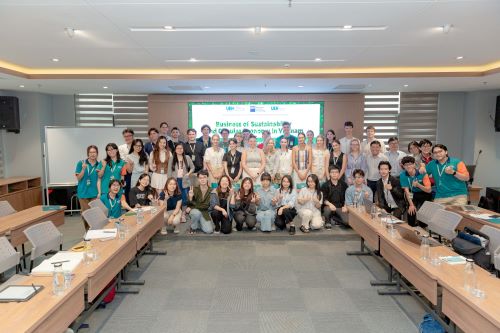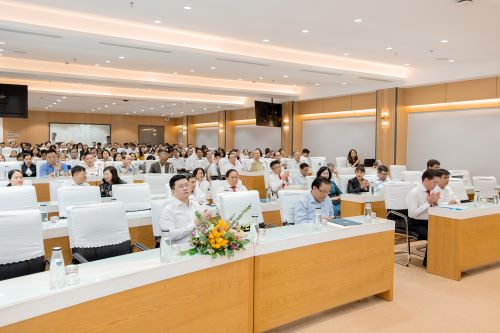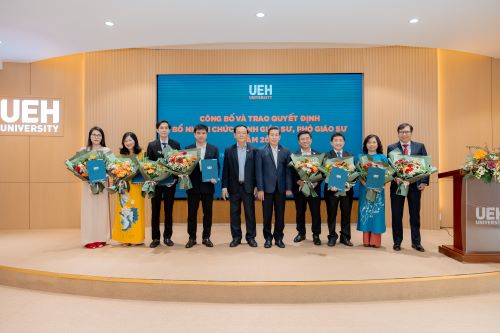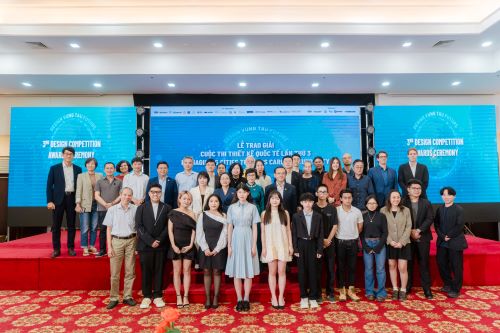
Global Uncertainty and Adaptation Strategies of Vietnamese Businesses
The ability to adapt and recover (resilience) of businesses to global shocks listed as epidemics, economic or political and military conflicts is one topic of the current researches and discussions in the context of the world that has been becoming more and more unstable. The inherent flexibility of the business sector as well as the rapid development of technology and digital transformation, has made the strategic planning of recovery and adaptation of Vietnamese enterprises a key issue as one interesting and trending topic. The government also understands that businesses are the backbone of the economy: if policies and support solutions do not reach the hands of businesses, it is difficult to think about their ability to grow sustainably and meet social security goals. In this article, the authors, with a view from policy design to corporate governance, have made a number of recommendations and implementation solutions to improve adaptability and to minimize the risk of business failure in particular and the economy in general.

“Unstable”, “growth”, “inflation”, “conflict” are the most mentioned phrases in recent times and of course what is caused by Covid-19 is not strange at this time. Over the past two years, the business operations have experienced unprecedented difficulties, they did not have to declare dissolution or bankruptcy are ‘admirable’ for their adaptability, financial potential, resource accumulation, and innovative thinking. Nevertheless, when global uncertainties are being taking place, exogenous shocks listed as epidemics and political conflicts can completely continue, the more it will require the response capacity as well as the change of business industry, especially in a transitional economy like Vietnam.
Adaptation strategy of Vietnamese enterprises
Vietnamese economy has recorded relatively impressive results in the recent years with GDP growth in the first quarter of 2022 approximately 5.03% compared to that of the same period in 2021 (Figure 1). The Consumer Price Index (CPI) remains in a safe zone with an increase of 2.1% in the first 4 months, and the weight comes mainly from gasoline prices (50% higher than that of the same period). Economic activity showed a recovery as the index of industrial production and retail sales of consumer goods and services grew at 9.4% and 12.1%, respectively, compared to that of the same period, returning to the pre-pandemic speed.
Export turnover has grown rapidly in recent months, respectively in March and April 2022, 17% and 25.2%, respectively. However, the import growth trend has not changed much because of the disruption in the supply chain from China; in addition, we continue to expect positive trends to come because the demand for input materials input into the processing and manufacturing industry will increase while domestic spending demand will continue to recover. Combined with tourism and current account remittances, it is estimated to reach 1.5% of GDP in 2022 and approximately 2% in 2023.
Credit growth continued to skyrocket at 16.4% in April 2022 and the balance in the state budget surplus for 4 consecutive months showed positive economic conditions and reduced budget expenditure. Finally, FDI capital was growing strongly but the level of registered capital tended to decrease in the first 3 months of the year. A promising sign is that the business environment index of Vietnam in the first quarter of 2022 has increased by 12 percentage points over the same period, equivalent to 73 percentage points, continuing to return to the time before the fourth wave outbreak.
With those positive signs, the forecast regarding the Vietnamese economic growth given by the Asian Development Bank (ADB) is 6.5% and 6.7% for 2022 and 2023, respectively. The World Bank (WB) record a growth forecast of 5.3% in 2022 and this will return to a stable level of 6.5% in the following years. The figure for the International Monetary Fund (IMF) is 6% in 2022 and 7.2% in 2023 although IMF has downgraded its global growth forecast for this year to 3.6%.
We have complete confidence in the above forecast numbers when right from the beginning of the year, specifically on January 11, 2022, a monetary and fiscal solution package of approximately 15 billion USD was used to implement the Economic Recovery and Development Program (ERDP) for the 2022-2023 period has been approved by the National Assembly. The program includes fiscal solutions listed as tax exemption and reduction, healthcare, infrastructure construction and development, social security, interest rate support for businesses and business households and so on.
In addition, monetary solutions, with the goal of credit growth in 2022 as 14%, aim to provide liquidity to the market by reducing lending rates from 0.5%-1% at credit institutions. In terms of the ERDP program, the economic stimulus packages from this program are aimed at increasing public investment and stimulating domestic demand, showing how to coordinate between the central and local governments. Along with that, the labor market has been gradually recovering, continuing to strengthen production and business activities. This continues to show that Vietnamese economic resilience is completely possible.
On the other hand, the post-Covid-19 growth momentum has hit a crossroads as the geopolitical instability between Russia and Ukraine has escalated. The economic sanctions against Russia have caused a sharp increase in the world oil prices. This is the cause of the increase in raw material prices as well as production and transportation costs, directly affecting product prices in the market, causing inflation (due to cost-push) as shown in Figure 2.
During this period, the price of gasoline rose to an all-time high. In accordance with the data from the American Automobile Association (AAA), the average price of gasoline across the United States reached a new record on May 10 at $4.37 per gallon, surpassing the record set on March 11 is $4.33 a gallon as global refiners grapple with supply chain bottlenecks that have sent prices soaring. The price of gasoline after the adjustment session on May 11, 2022, in Vietnam, has reached the threshold of nearly 30,000 VND/liter. Facing this situation, the government has issued supportive policies on environmental protection tax to partially cool down domestic gasoline prices. Along with that, that the moves to tighten credit valves and gradually increase interest rates were made in the context of the Covid-19 pandemic is gradually being viewed as an endemic disease to avoid the overgrowth of the economy to the point of losing control, when signs of inflation are gradually appearing. As the global economy gradually adjusts to the “new normal”, business leaders tend to balance a strategy of cutting costs without hurting business operations, increasing tightening the fiscal year, Central Banks introduced policies to reduce asset purchases and the amount of money injected into the economy to stimulate growth; besides, businesses focused on changing directions on factors that help growth to prepare for the impact of the prolonged Covid-19 pandemic.
Challenges and implications for adaptation strategies
* From a policy perspective
Although our Vietnamese economy has shown positive signs, the prospect contains risks and challenges. The first is related to the high number of Covid-19 infections that may hinder the economic recovery process in 2022. Besides, the uncertainties slow down the recovery of the global economy, the military conflicts listed as the case of Russia and Ukraine that caused the world oil price to rise, affecting the cost of input materials, thereby, putting pressure on inflation and macro management policies. The inflation in Vietnam is forecasted to increase to 3.8% this year and to be closely right at the target of 4% in 2023, meaning that the tolerance level has reached its limit. Along with that, Chinese ‘zero Covid’ policy partly caused this country to slow down their growth rate, affecting Vietnamese import and export activities. It is the problems related to bad debt is also a risk to consider, especially in the medium term when Vietnamese potential bad debt ratio is approximately 8.2%. In the end, whether the ERDP program is completely effective and supports the right audience depends on how quickly or slowly the policy is implemented, procedures and processes must be simplified and need to be synchronized between the national central government and other localities.
Therefore, with a long-term vision, some policy suggestions to create for businesses in Vietnam are as follows:
- It is necessary to ensure the principle of consistency, stability and timely communication of solutions in monetary policy and fiscal policy.
- Financial and credit solutions to support businesses need to be timely and to the right audience.
- Supportive packages must be deployed quickly, directly and shorten the process.
- Promulgating specific solutions to support workers in localities to return to provinces and cities so as to meet the process of production and business recovery.
- Innovating mechanisms and policies, establishing a new legal framework that both encourages and forces businesses to have innovative thinking, apply technology, and at the same time promote and support the completely-digitized businesses.
- Implementing a pilot mechanism listed as a “sandbox” for new fields listed as FinTech to help regulators understand and understand how it operates and the risks it may face.
- Strengthening national scientific and technological capacity, being able to master and creatively applying new scientific and technological knowledge to the economy and more specifically to Vietnamese enterprises. Promoting investment and development of technical infrastructure.
- Develop a plan to develop high-quality human resources in the new context, from the perspective of strategic planning to practice in practice.
- Actively and proactively integrating into the world to acquire external resources and combine them with internal resources to aim at sustainable economic development based on technology and innovation.
*From a business perspective
Designing and building a common strategy for all businesses can be difficult because of differences in industry, model and management thinking. However, in order to shape the appropriate direction in the new context, the following suggestions will be feasible:
- Well-controlling cash flow and working capital to maintain liquidity.
- Streamlining the process, optimize costs, cut inefficient investments.
- Taking advantage of supportive policies from the government listed as relaxation, tax deferral, subsidies, financial support, preferential loans, loan restructuring.
- Applying digitalization and innovation in commercial activities, production, business, management, etc.
- Diversifying input and output markets, improve initiative and flexibility.
- Monitoring the general situation of the world and the epidemic and grasping the Government’s policies to develop appropriate adaptation and response scenarios.
- Searching and expanding investment channels and capital mobilization channels.
- Changing previous strategies to adapt to the post-Covid-19 context, focusing on sustainable production and business.
In addition, businesses will rely on the development trend from time to time to develop a diversified strategy. In order to adapt to adverse circumstances, businesses need to develop a scenario to cope with adverse circumstances for businesses, in addition to focusing on micro issues like before, it is necessary to consider expanding the effects of the macro. Well controlling the increase in supply chain costs due to the impact of supply chain disruption. Being in need of the strong, synchronous and pervasive bounces between the government and businesses. In other words, the government and the businesses need to ensure the initiative, to make timely strategies and policies and to be ahead of the trend; concurrently, there must be interaction with each other, businesses must be ready and the government must also play a role of creating and monitoring.
Please refer to the full research Global Uncertainty and Adaptation Strategies of Vietnamese Businesses at Conference yearbook “Reshaping the global financial system and strategies for Vietnam – Part 2”. Author group: Assoc. Prof. Dr. Nguyễn Khắc Quốc Bảo, MSc. Tô Công Nguyên Bảo and MSc. Trần Nhật Hoàng, UEH.
This is in series of spreading researches and applied knowledge from UEH with “Research Contribution For All – Nghiên Cứu Vì Cộng Đồng” message, UEH would like to invite dear readers to follow Newsletter ECONOMY NO. #52 “The 4.0 technology application development in agriculture at Dong Nai Province”.
News, photos: Author group, UEH Department of Marketing – Communication






